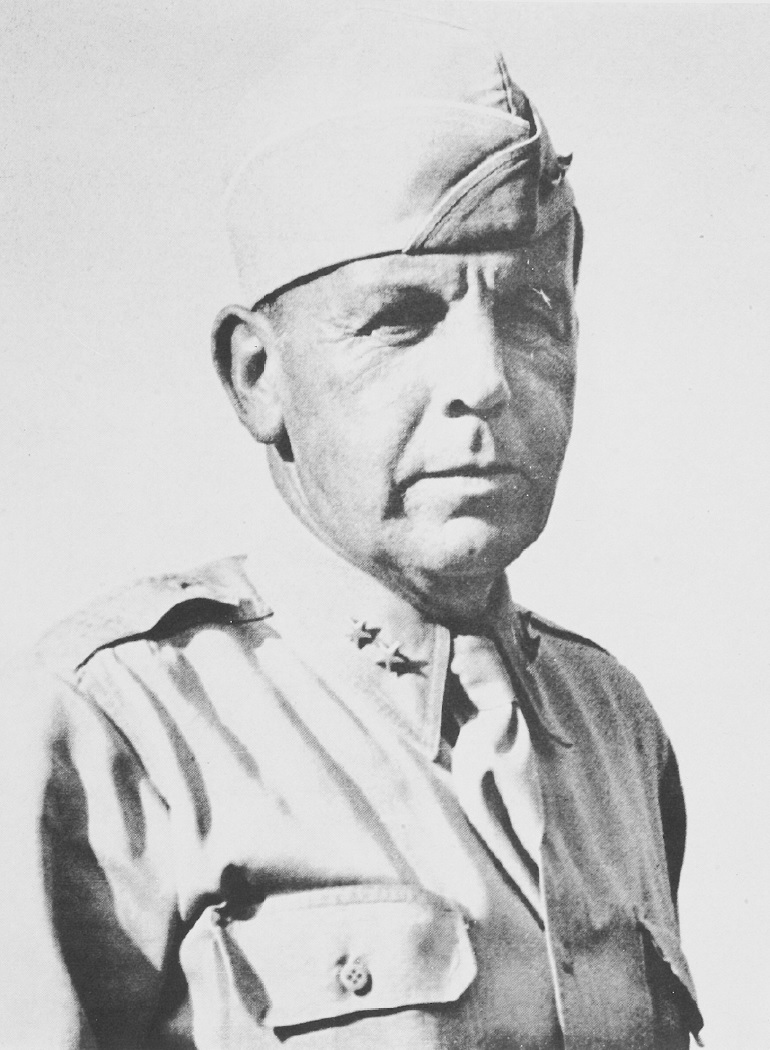
Eight Army Field Order No. 21
Eight Army Field Order No. 21, published on March 1, 1945, designated the 40th Division, reinforced, (less the 108th Regimental Combat Team) as the task force to carry out the Victor-I Operation. The 503d Parachute Regimental Combat Team was placed in Army Reserve.
Field Order No. 21 assigned the following combat units, totalling 11,809 men, to the operation:
40th Division (-108th RCT) 9,732
470th AAA AW Bn (-Btries C and D) 4O8
716th Tank Bn (-Companios A and B) 486
Company A (-1st Plat) 658th Amp Trac En 160
Det, Hq and Hq Co., 542nd Engr B and S Regt 25
Companies C and D, 542nd Engr B and S Rept 566
Det, 592d JASCO 25O
15th Support Aircraft Party 15
Company B, 8Oth Cml Mortar Bn 167
In addition, 2,395 service troops were allocated to support the operation.
The Commander, Naval Attack Force, was charged with the control of all amphibious operations. Control of forces ashore was to pass to the Commanding General, 40th Division, upon his arrival ashore.
Pre-Invasion Bombardment Begins
Aerial bombardment by planes of the 5th and 13th Army Air Force, and Marine Air Group 14 began on March 1, 1945.
As in previous amphibious landings, the objective area was softened up by aerial pounding before the invasion by ground forces. Starting on March 1, nearly three weeks before the assault forces were to land, Marine and Thirteenth Air Force fighters made almost daily aerial attacks on Panay, aiming at enemy installations and troop concentrations. Meanwhile, allied naval forces harassed the enemy's overwater communications in guimaras and iloilo straits.
Need for Aerial photographs
To provide for the prompt seizure of the City of ILOILO after the assault, it was highly desirable that the landing be made as near the city as possible. To supplement the information available, vertical and oblique photographs of the area were desirable.
Good verticals are needed to study possible landing beaches and defenses in the initial planning phase. Low oblique flown at 800 feet or less are needed to brief scouting parties, control and landing craft, gunfire support ships and the whole operating forces as a whole.
Aerial photographs requested from Eight Army
On 1 March 1945, a representative of this group had arrived in LEYTE and made inquiry as to photographic coverage. It was learned that EIGHT Army had already ordered coverage.
It was learned that the EIGHT Army had obtained aerial coverage of the beach area and, accordingly, copies of the photographs were requested by dispatch.
Numerous despatches concerning requests for photographic coverage were exchanged with EIGHT Army.
As a practical matter the Amphibious Group correlates its request for coverage with the Army group concerned with the specific operation as far as practicable. However, the needs of the two groups are not always identical.
Engagement in Manguna, Cabatuan, Iloilo
Death Casualty:
Pvt. Gabriel Amboyog, March 1 1945, Manguna, Cabatuan, Iloilo
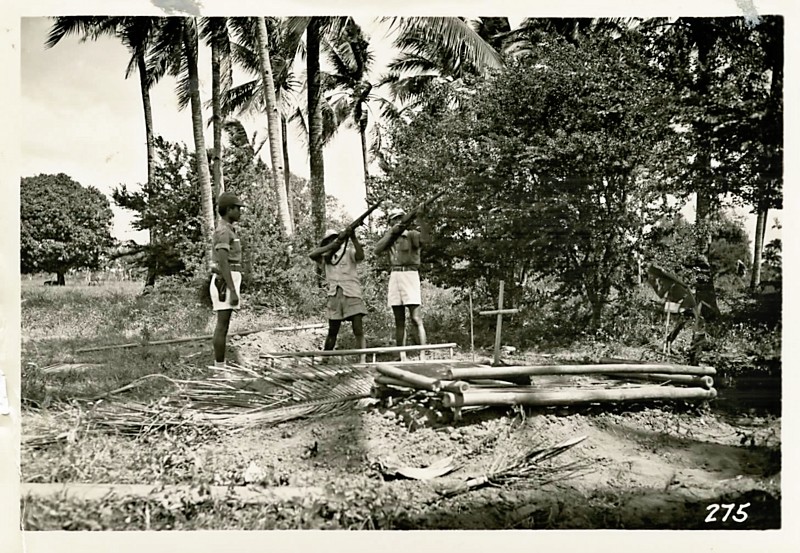
Guerrillas giving final salute to one of their departed comrades

Rear Admiral Struble designated Attack Group Commander of Victor One operation.
3 March 1945. Commander Amphibious Group NINE was located on this date at SUBIC BAY aboard the U.S.C.G.C. INGHAM. Rear Admiral STRUBLE was designated Attack Group Commander of VICTOR ONE Operation by Commander SEVENTH Amphibious Force dispatch on 3 March.
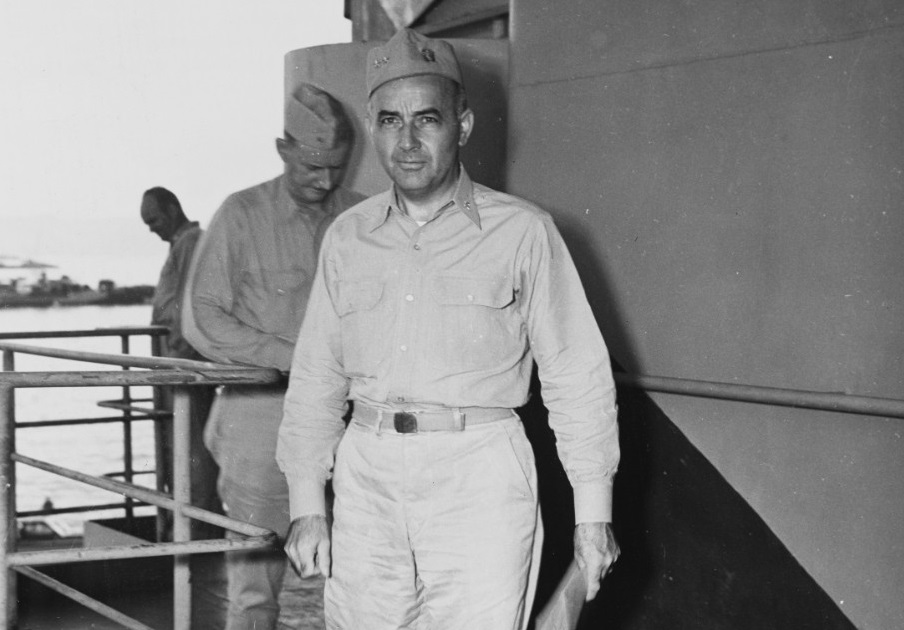
Rear Admiral Arthur D. Struble, circa December 1944
Secret dispatch designates Task Group 74.2 (Rear Admiral RIGGS) to provide cover and support.
Commander Task Force 74, in his secret dispatch of 3 March 1945, designated Task Group 74.2, under the command of Rear Admiral RIGGS, to provide cover and support for the operation.
Aerial photographs also requested directly from 13th Air Force
On 3 March this group also requested vertical and oblique coverage directly from THIRTEENTH Air Force.
It would be advantageous, particularly when a Task Group is performing the planning function at a place distant from the higher ecelons if the arrangements for the coverage and delivery could be accomplished directly between the air force and the Task Group.
Engagement in Pamul-ogan, Cabatuan, Iloilo
Death Casualty:
Pvt. Andres Musca, March 3 1945, Pamul-ogan, Cabatuan, Iloilo

Aerial Photographs of objective area received after considerable delay.
On 10 March, 9 days before the target date, 1 set of verticals at scale 1:10,000 was received.
A delay until 10 march in receiving the desired coverage created considerable delay in the final selection of beaches.
Late receipt of photographic coverage seriously hampered planning and execution of this operation.
Reproduction facilities aboard USS Ingham lacking especially for Aerial Photographs.
There are no facilities aboard a CGC for reproducing charts and photographs and unless the Flagship is located near adequate reproduction facilities, detailed and accurate operation maps and charts cannot be produced. Mimeographed material is the only substitute.

Reconnaissance Party lands and inspects beaches west of Oton.
The aerial photographs received are apparently use to study possible landing beaches and to brief the scouting party.
A reconnaissance party inspected the beach west of OTON and its immediate approach on 10 - 11 March and found that it might be suitable for beaching craft as large as LSMs. The reconnaissance party was detected by natives without untoward consequences. Reconnaissance of other beaches was not feasible with the time remaining prior to the landing.
Beach Reconnaissance. A trained Amphibious Scout Team consisting of one officer and two enlisted men was landed(?) to determine profiles, shifting sandbars and texture of the submerged beach together with a limited examination of exposed beach and exits in the beach areas west of OTON.
Red Beach is selected for the landing. Blue Beach established as alternate.
In collaboration with the Army, two beaches were selected which promised to afford the optimum advantages of proximity to the objective and acceptable landing conditions. These were:
(a) RED BEACH, to the east of the SIBALOM RIVER at TIGBAUAN.
(b) BLUE BEACH, to the west of the SIBALOM RIVER.
The Army preferred RED BEACH, as it obviated a crossing of the SIBALOM RIVER. RED BEACH was selected for the assault landing. It appeared that LCMs could be beached and the assault troops landed satisfactorily. Its suitability for unloading LSMs and LSTs was uncertain, because of the gradient and, therefore, BLUE BEACH was established as an Alternate.

LSTs and LSMs commence loading at Lingayen.
Four days were allowed for loading 15 LST's and 9 LSM's at LINGAYEN. Since the loading beach was narrow with a small gradient, all of this time was needed. The loaded ships were retracted on schedule with the help of tugs and LCI's. The ships were properly loaded.

Rear Admiral Riggs boards Ingham for conference.
Rear Admiral RIGGS boarded the INGHAM, 12 March, for a conference to arrange the cruiser cover.

Briefing Conference aboard USS Ingham.
On the morning of 13 March 1945, unit commanders of Task Group 78.3 and Major General RAPP BRUSH, Commanding General, 40th Infantry Division, with his staff, boarded the INGHAM for the briefing conference.
0920 13 March 1945. Commander Amphibious Group NINE, at anchor in LINGAYEN GULF, held a briefing conference on the Flagship for all elements of the Attack Group.
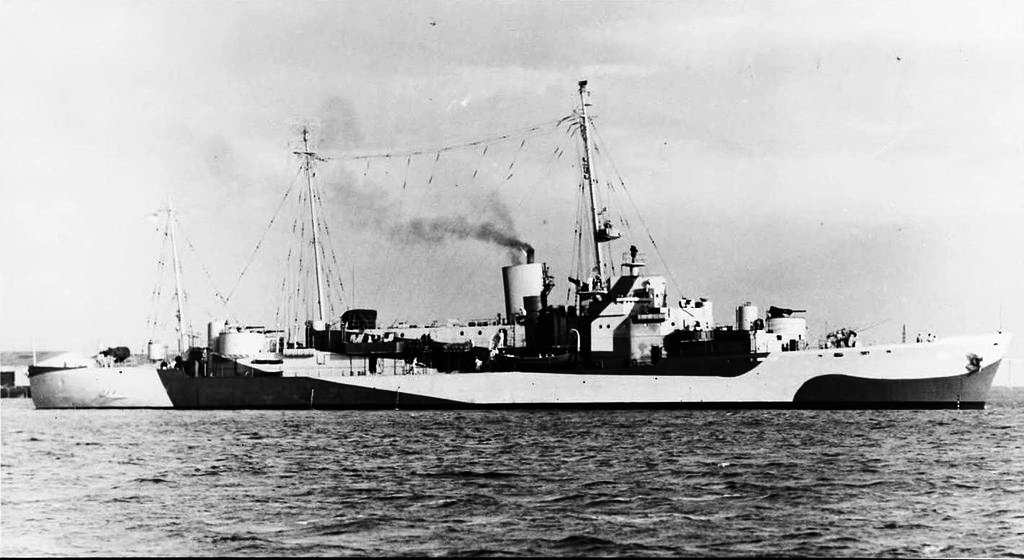
USS Ingham as an amphibious flagship, Oct 1944
Assigned destroyers have not reported yet.
1100 13 March 1945. The destroyers assigned for the VICTOR ONE Operation have not reported yet. Commander Task Force 78 was therefore requested to have them report.
Struble confers with Eichelberger.
1130 13 March 1945. Rear Admiral STRUBLE went ashore for a conference with General EICHELBERGER, Commanding General, EIGHTH Army, at FORTIETH Division Headquarters.
Minesweeping drill.
1330 13 March 1945. Minesweeping Drill was held by LCVP's and LCM's towing size 5 m/s gear.
Rehearsal of the landing not held.
A rehearsal of the landing was not held, because the LCMs which formed a considerable part of the assault waves were not at the staging area, and the LSTs carrying the LVTs were not loaded until the afternoon before sailing.
The LCM's would come from Leyte and would join the convoy at Mindoro.
The Leyte component assembling at Mindoro.
The Task Group was comprised initially of two units; the major unit assembling at LINGAYEN and the other assembling off MINDORO.
The MINDORO unit consisted of HMAS WARREGO, LST 721, LSM 267, LCIs 579, 663, ATR 61, 35 LCMs to be towed, 5 LCVPs to be hoisted in LSTs. It was planned that the junction of these two units take place south of MINDORO at daylight on D minus 1 Day, to take the LCMs in tow. The arrangement permitted towing the LCMs at reduced speed and provided sufficient time for the arrival off the beachhead as scheduled.
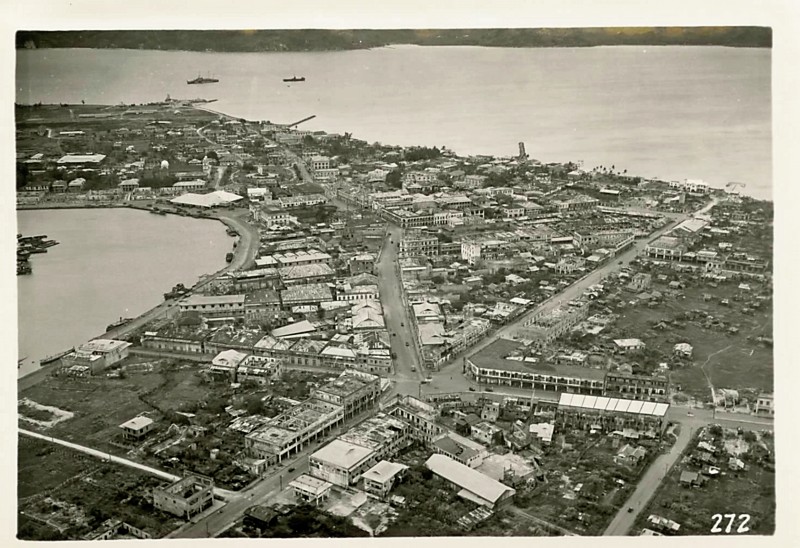
Aerial View of Iloilo

Major General Rapp Brush and staff board the Ingham for departure tomorrow.
0900 14 March 1945. Commanding General, FORTIETH Division and Staff Officers boarded Flagship for passage to objective area.
Final arrangements are made.
1035 14 March 1945. A SEVENTH Fleet Intelligence Unit reported aboard for the operation. During the day final arrangements were made for getting underway.
Aerial photographs.
It was not until the afternoon of 14 March when the Task Group was getting underway that 1 set of obliques was received.
Loading of ships completed.
2300 14 March 1945. Loading was completed at this time and all ships retracted.
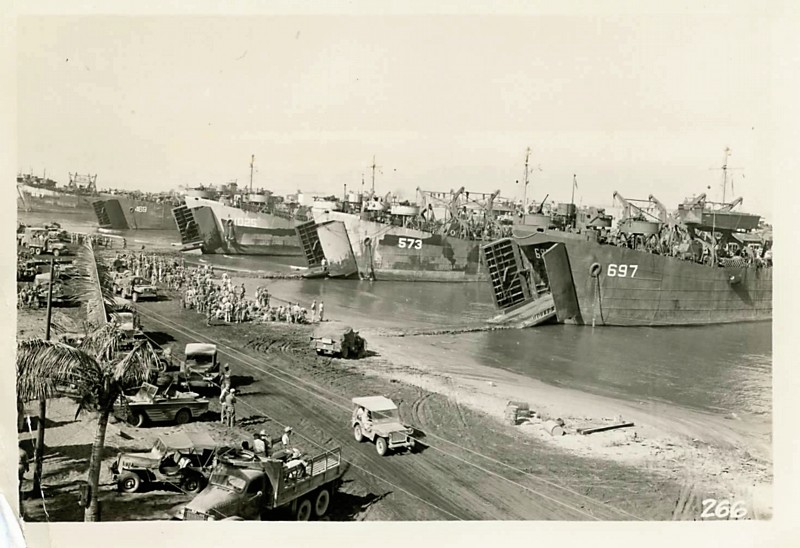
LST's loading at San Fabian before leaving Luzon

Lingayen component assembles into convoy formation and leaves Lingayen.
At 0730, 15 March (D minus 3 Day), the INGHAM, OTC and Guide, passed through a point at Latitude 16° - 10' N., Longitude 120° - 15' E., in LINGAYEN GULF, on course 343° True, speed 5 knots, and the Task Organization, less the MINDORO Unit, sortied and formed up in cruising disposition CHARLIE ONE, and steamed en Route SQUIRREL-CARIBOU for TIGBAUAN, PANAY.
0643 15 March 1945. Underway in the Flagship.
0736 15 March 1945. The Flagship passed through the rendezvous point established in the plan.
0856 15 March 1945. Three cruisers of Commander Task Group 74.2 with their screen closed in, overtaking the formation on the starboard quarter.
0900 15 March 1945. Cruising disposition C-1 formed.
Air Cover does not report yet.
The information of the Attack Group's departure on G-3 day was not sufficiently promulgated by the Army Air Commands concerned, causing the convoy to have to use the local CAP of the LINGAYEN GULF Area until the proper authorities could be notified and action be taken by them.
0905 15 March 1945. No regular air cover has reported yet, however, P-38's and P-47's of the LINGAYEN GULF CAP are flying overhead.
Cruiser and screening destroyers pass formation on starboard side.
0925 15 March 1945. The three cruisers and screening destroyers passed our formation on the starboard side.
All LST's are now in formation.
0935 15 March 1945. All LST's are now in formation.
Two P-51's finally report for air cover.
1330 15 March 1945. Two P-51's have reported for air cover.
USS Dyson joins the formation.
2115 15 March 1945. U.S.S. DYSON (DD 572) joined the formation.
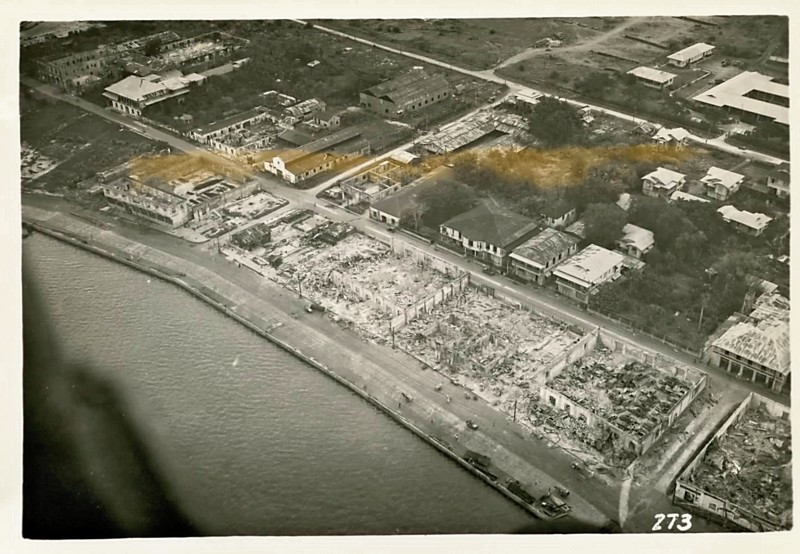
Aerial View showing damage done by American planes to Jap warehouses in Iloilo Harbor

LCI(M) 359 joins Lingayen convoy.
LCI(M) 359, out of SUBIC BAY, joined the convoy at Point PIN at 0725, 16 March (D minus 2 Day).
0730 16 March 1945. LCI(M) 359 joined formation.
P-38s arrive to provide air cover to the convoy.
This discrepancy (lack of air cover yesterday) was corrected by G-2 day. Thereafter, the Attack Group had its own CAP as per the Operation Plan. While enroute to the objective area, there were no other but routine air operations.
0800 16 March 1945. Four P-38's reported on station as CAP.
USS Converse given instructions.
1048 16 March 1945. The CONVERSE was ordered to close the Flagship for instructions regarding a special mission.
1120 16 March 1945. The following instructions were given to the CONVERSE - "Assault convoy proceeding to effect rendezvous early evening 16th, with Love Charlie Mikes assigned for assault, off MINDORO inshore of route MOOSE in order to take them in tow in loc of MINDORO. Due to weather conditions I may alter route to objective area and stay eastward and inshore of route MOOSE after passing south of latitude 11-50. Request northbound convoys be informed."
Contact with other ships.
1152 16 March 1945. Convoy of ships reported at bearing 220 - distance 42200 yards.
1225 16 March 1945. Surface contact at bearing 135 degrees, distance 22000 yards was reported by CONVERSE.
YMS 364 is taking in water but pumps are handling it.
1245 16 March 1945. Message was received from YMS 364 as follows: Have open seam in engine room and am taking water. Pumps at present handling it. Will keep you advised.
LST 469 proceeding under hand or auxiliary steering control.
1425 16 March 1945. The LST 469 on the Flagship's port quarter was observed flying the international hoist meaning "Am proceeding under hand or auxiliary steering control". The ship is in her assigned station.
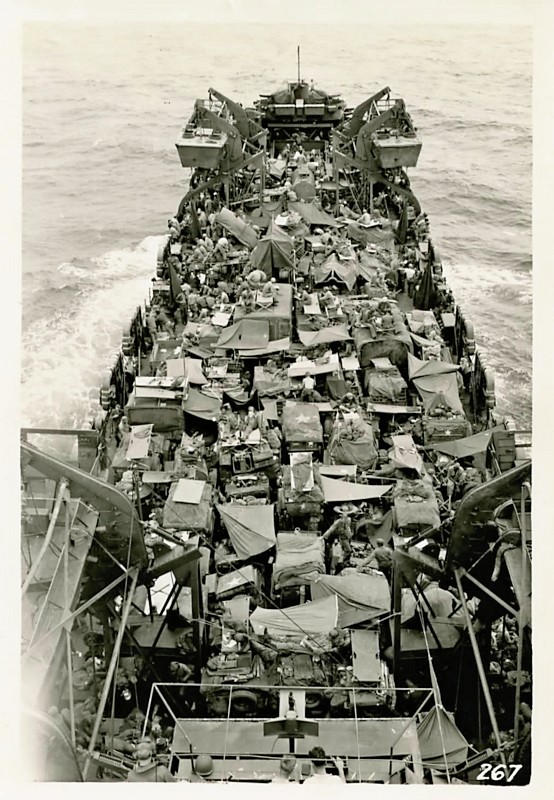
Aboard a rather crowded LST, en route to Panay
Convoy encounters heavy weather, moves closer inshore.
1543 16 March 1945. The Task Group moved closer inshore due to heavy weather.
Weather necessitates change of Mindoro rendezvous location.
During 16 March the wind and sea freshened and created doubt as to the feasibility of taking the LCMs in tow at the prearranged rendezvous. The YOUNG (DD580), attached to the Covering Group, and then in the vicinity of MINDORO, was sent to a station south of MINDORO to report sea and weather conditions. The YOUNG's reports dictated that a change of rendezvous to one to the westward of MINDORO was Advisable. Accordingly, HMAS WARREGO, in the MINDORO Unit, was directed to essemble the LCMs and rendezvous with the Task Group Commander west of MINDORO.
The CONVERSE was directed to depart immediately and assist WARREGO in getting the LCMs underway and effecting the rendezvous.
LST 666 broken down.
1622 16 March 1945. LST 666 has broken down and is falling out of formation.
1900 16 March 1945. LST 666 regained assigned station.
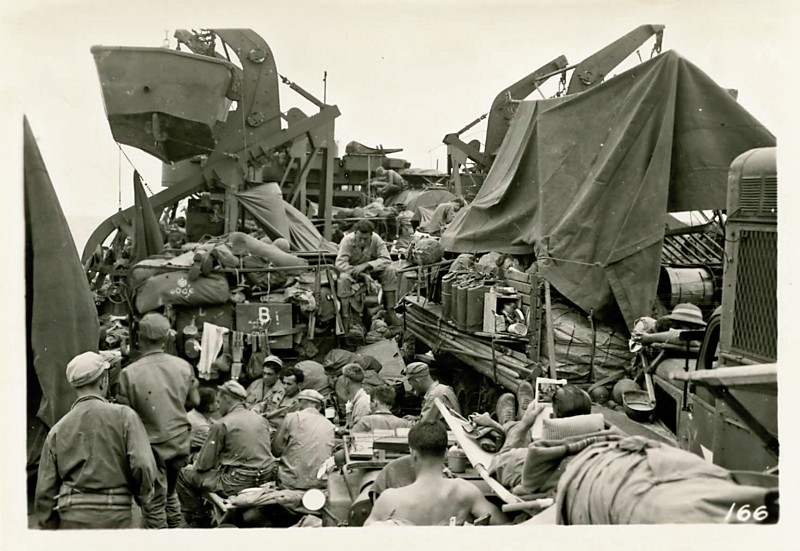
En route to Panay aboard an LST
SCs dropping to the rear.
1910 16 March 1945. The two SC's are dropping back to the rear of their respective columns. SC 749 is to starboard and SC 748 to port.
Lingayen convoy approaches Leyte/Mindoro component at Mindoro.
2005 16 March 1945. Course was changed to 152 degrees True.
2010 16 March 1945. A target has been picked up about 15 to 20 miles away.
2016 16 March 1945. The DE harbor patrol craft challenges INGHAM.
2028 16 March 1945. LCM's believed to be the original target bearing 154 degrees- distance 20 miles, have split up into two groups.
2030 16 March 1945. Commander Task Group 78.3 asked the patrolling DE how many ships are in her screen. DE reported she is the only patrol craft there.
2053 16 March 1945. CONVERSE reports that she believes she is the ship to the south of us bearing 344 degrees - distance 5 miles. The CONVERSE also states that WARREGO is about 7 miles to the east of us now.
Lingayen convoy stops at Mindoro.
2136 16 March 1945. Commander Task Group 78.3 gave the order for certain ships designated to turn on their truck lights. Speed was reduced to 4 knots.
2137 16 March 1945. Commander Task Group 78.3 orders speed zero.
Leyte/Mindoro component joins up.
The MINDORO Unit joined the attack Group Commander at 2152, 16 March, off SAN JOSE.
2153 16 March 1945. The THATCHER reported numerous small craft about 3000 yards on our port beam preparing to join us.

LCVPs are hoisted by designated LSTs and the LCMs are in tow by LSTs, LSMs and LCIs.
By 0041, 17 March, the LCVPs had been hoisted by the designated LSTs and the LCMs were in tow by LSTs, LSMs and LCIs. The attack Group then proceeded.
0041 17 March 1945. All landing craft Unit Commanders have reported that LCM's have been taken in tow. There are a total of 34 LCM's.
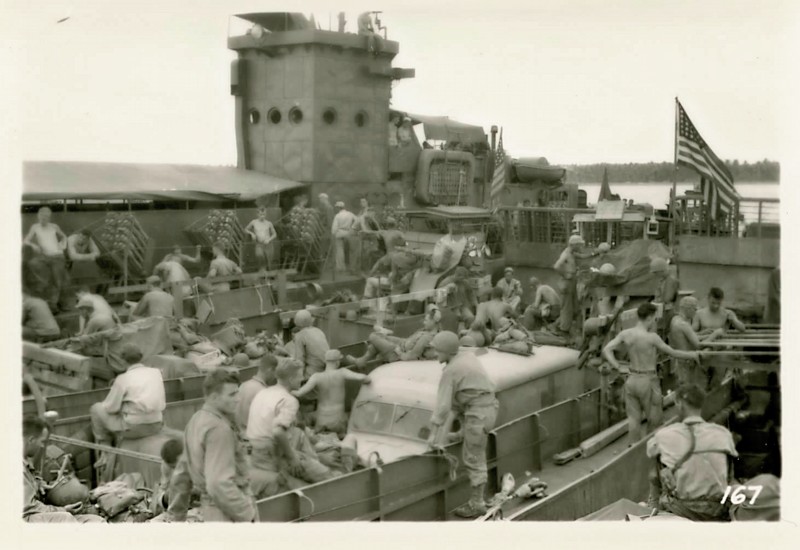
LCM's rendezvousing alongside an LCI rocket craft
Convoy proceeds.
0058 17 March 1945. The formation got underway at speed 5 knots.
LST 935 loses her tow.
0456 17 March 1945. LST 935 lost her tow and dropped back to regain it.
LSM 54 reports engine trouble.
0650 17 March 1945. LSM 54 reported engine trouble. One starboard engine is out but she will be able to maintain present speed.
PCE(R) 850 joins convoy.
PCE(R) 850 joined the Attack Group on 17 March and was assigned screening station.
1248 17 March 1945. PCE(R) 850 reported to Commander Task Group 78.3 and took here place in formation.
Minesweeping unit taking station ahead of the convoy, prepares for detachment.
1545 17 March 1945. YMS's 363, 334, 314, 364, 329, WARREGO and THATCHER (DD 514) are taking station ahead of the formation.
1607 17 March 1945. Commander Task Group 78.3 advises the THATCHER he plans to detach his group about 1900.
USS Claxton is directed to redirect other ship traffic.
1630 17 March 1945. Commander Task Group 78.3 advises 78.3.5 that it is his present intention to sail the Attack Group between route MOOSE and NASO POINT to objective area and that the desire to avoid interference from north-bound traffic in the vicinity of NASO POINT. Commander Task Group 78.3 then directed that one DD take station 10 miles ahead of disposition at 1800/I, until the Attack Group heads up for point ZAG, to divert traffic to westerward of our formation.
1700 17 March 1945. The CLAXTON (DD 571), proceeded to carry out instructions to direct traffic westward of Group.
SCs move up to head of column.
1720 17 March 1945. SC's move up to head of column as directed.
Minesweeping Unit detaches and proceeds ahead to carry out minesweeping.
1936 17 March 1945. Commander Task Group 78.3 instructed THATCHER as OTC and escort, to proceed with WARREGO, LCI(N) 359, all YMS's to carry out instructions.
At 1937, 17 March, THATCHER, WARREGO, LCI(M) 359 and the Minesweeping Unit were detached, in order to proceed ahead and carry out the minesweeping plan.
The Minesweeping Unit and the Fire Support Ship experienced difficulty in orienting themselves in their assigned areas, with the consequence that both the minesweeping schedule and fire support schedule were delayed slightly in starting.
USS Claxton redirecting other ship traffic.
2150 17 March 1945. CLAXTON was heard advising northbound ship of our disposition bearing 346 degrees distance 27 miles, course 170 degrees and that Commander Task Group 78.3 desires northbound ship to keep to westward.

LCI 548 collides with LCI 29.
0215 18 March 1945. LCI 548 has collided with LCI 29. LCI 548 has a hole in her bow.
Minesweeping unit.
0432 18 March 1945. The THATCHER will direct that minesweeping gear to be streamed at 0530.
0430 18 March 1945. THATCHER reports that YMS's will be released. They will either stop or steam very slowly. WARREGO will take station well clear on the port quarter and move in on assigned duty with YMS's when they proceed. LCI 359 will remain clear astern.
0451 18 March 1945. THATCHER reports that YMS 329 has lost all power and is dropping astern of the formation. He expects to regain power shortly.
0453 18 March 1945. YMS 329 is now joining formation.
0522 18 March 1945. The Minesweeping Group reports a target about one mile ahead of WARREGO. WARREGO will investigate. The target appears to be a small boat according to report. The minesweepers are about four to five miles ahead of the convoy.
0545 18 March 1945. THATCHER reports she can now see what appears to be boats along the beach half mile to the west of objective.
0546 18 March 1945. Course changed to 000.
0600 18 March 1945. Speed changed to 4 knots.
0630 18 March 1945. Commander Task Group 78.3 told THATCHER that it looks as if the YSM's are short of proper position. THATCHER reports she will get them in position as soon as possible.
USS Thatcher bombards shore points.
0509 18 March 1945. Latest Guerilla reports indicate about 30 Japs dug in in vicinity TIGBAUAN church and about 20 Japs on a hill called CORDOVA TIGBAUAN. Both groups are surrounded by Guerillas and unable to support each other. THATCHER has been directed by Commander Task Group 78.3 to fire at the first target for about five minutes.
0652 18 March 1945. THATCHER reports she has been unable to observe any activity on the beach as yet.
0653 18 March 1945. Destroyer commenced firing on beach.
Commencing at 0653, 18 March, scheduled fire was directed against designated strongpoints in the TIGBAUAN Area.
USS Thatcher bombards the wrong target initially, bombards Guimbal instead of Tigbauan.
0700 18 March 1945. THATCHER believes she is firing on the wrong target.
0710 18 March 1945. Commander Task Group 78.3 advised THATCHER that it appears she is approaching on GUIMBAL instead of TIGBAUAN. DD reported she was on the wrong target when firing began but she is on the right one now. She is conducting bombardment to drive Japs out of TIGBAUAN and prevent destruction of TIGBAUAN bridge.
The U.S.S. THATCHER (DD 514) opened fire on the wrong area, and fired a few salvos into the town of GUIMBAL before the O.T.C. ordered her to cease fire. There were no casualties inflicted. THATCHER then opened fire on TIGBAUAN area.
USS Thatcher bombarded Guimbal because it is also located on the east bank of a river with a prominent bridge.
Due to an error in orientation and to the fact that two towns in the objective area were both located on the east bank of a river with prominent bridges one destroyer fired several rounds at the wrong target.
Aerial photographs of the objective area might have prevented the error.
Low altitude oblique photographs of the objective area might have prevented this.
It is recommended that low obliques of the target areas be furnished in sufficient time so that each firing ship may be supplied with a copy in future amphibious operations.
It is reconmended that the SCR 284 radios with which the 592nd JASCO is equipped be replaced by one of a light and less bulky type.
Covering group arrives at assigned station.
At 0700, the Covering Group, consisting of the CLEVELAND, CONWAY, EATON and STEVENS, arrived on assigned station 20 miles southwest of ILOILO. The Attack Group stood in toward RED BEACH. Natives were observed near BLUE BEACH and TIGBAUAN BRIDGE. The scheduled gunfire was delayed until further orders.
Ingham anchors off right flank of beach.
The flagship left the formation and anchored on the right flank of RED BEACH, to observe the activity on the beach and to assist the ships underway to keep station off the proper beach. Landing ships and craft were ordered to cast off LCM tows and the Attack Group was ordered to deploy.
0720 18 March 1945. Moved Flagship to anchorage off right flank of beach.
Control Unit and LSTs cannot anchor except close in-shore
The depth of water in PANAY GULF west of OTON BANK does not permit anchoring except close inshore. The location of both RED BEACH and BLUE BEACH positioned the transport area and line of departure in deep water. Maintaining the prescribed stations under the prevailing conditions of a strong wind and heavy tidal current was extremely difficult for the LSTs.
Delay is made for the Control Unit and LSTs to move in-shore and anchor. H-Hour changed from 0830 to 0900.
H-Hour was delayed one-half hour, so the Control Unit and LSTs loaded with LVTs could be moved close in-shore and anchored.
0720 18 March 1945. H-Hour changed to 0900 instead of 0830.
Control Ships ordered to take station.
0720 18 March 1945. Control ships, SC 748 and 749, ordered to take station.
0724 18 March 1945. No movement or activity of any kind is observed in the target area.
0730 18 March 1945. Control vessels are not on station. Ships are ordered, when transport vessels have cast off tows, to follow flagship to boat lane near transport area.
0738 18 March 1945. Commander Task Group 78.3 told SC 748 and SC 749, the control vessels, to move eastward to proper position, using best speed.
SOC-3 observation planes report on station.
0740 18 March 1945. Two SOC-3 observation planes reported on station. Have instructed them to examine docks and straits for small craft.
Scheduled gunfire is delayed.
0748 18 March 1945. All scheduled gunfire is delayed until further orders.
Natives are seen on the beach.
0751 18 March 1945. People on the beach are sitting around in groups near the TIGBAUAN bridge.
0759 18 March 1945. Natives are now observed on landing beach.
By this time groups of natives waving white flags were collecting on RED BEACH.
Air Support doesn't report yet. Suffers the same misfortune as the Air Cover.
On G-Day in the objective area from 0800 until 1100, Air Support suffered the same misfortune as the CAP. This was due to a misunderstanding at Air Force Headquarters.
LSTs directed to anchor so they can discharge LVTs.
0805 18 March 1945. LST's 613, 469, 667, and 924 are directed to anchor in about 10 fathoms of water in boat lane and discharge LVT's.
Boat teams embark on LCMs.
0810 18 March 1945. LST's embark boat teams in LCM's.
Control Ships are now on station.
0816 18 March 1945. SC 748 and SC 749 are on station.
0825 18 March 1945. There is a white flag on beach bearing 320 degrees True.
Scheduled gunfire is cancelled.
The general naval gunfire support plan was as follows:
(a) A naval bombardment of southwest TIGBAUAN area by designated forces ccmmencing about HOW Hour minus 1 hour and 45 minutes, for purpose of driving Japs out of the area and preventing destruction of TIGBAUAN Bridge.
(b) A naval bombardment of the assault area by designated forces commencing about HOW Hour minus 60 minutes. Landing beach and flanks will be covered.
(c) Close supporting fire by LCI(R)s which will precede the leading waves.
(d) Call and counter battery fire by destroyers.
(e) Cruiser will furnish gunfire as ordered by O.T.C.
The O.T.C. cancelled all pre-arranged gunfire at HOW Hour minus seventy two minutes.
0828 18 March 1945. All gunfire for landing is cancelled.
The scheduled gunfire was cancelled.
LSTs are now anchored. They are instructed to send LVTs as soon as they are ready.
0830 18 March 1945. LST's instructed to send the LVT's in as soon as they are ready.
Guerrilla from shore.
0838 18 March 1945. LCVP is now going into beach with Army personnel to get Guerilla Officer to talk to the Commanding General, FORTIETH Division and Commander Task Group 78.3.
0842 18 March 1945. Many natives rush to greet LCVP containing Army personnel.
0856 18 March 1945. Guerilla brought aboard from beach questioned. He says there are 35 Japs in TIGBAUAN who cannot get out. They are surrounded by Guerillas.
LSTs launch first wave of LVTs.
0840 18 March 1945. Launched 1st wave of LVT's.
0849 18 March 1945. 1st LVT is in the water from LST 924 and others are following.
At 0850, the designated LSTs commenced discharging LVTs into the boat lane.
LVTs proceed to line of departure.
0855 18 March 1945. LVT's are proceeding to Line of Departure.
0855 18 March 1945. Two LVT's as guides take station ahead of 16 LVT's.
LVTs proceed to shore, guided by an LCVP.
0856 18 March 1945. An LCVP starts in ahead of LVT's as guide.
0856 18 March 1945. Surf conditions on the beach are good.
Air Support planes arrive.
0855 18 March 1945. Our support planes are now overhead.
Three LVT waves, followed by an LCM wave, land unoppose.
The first wave landed unopposed at 0906, to be followed closely by the second and third LVT waves and the fourth wave of LCMs. The LCMs nearest the west flank of RED BEACH made dry landings.
0906 18 March 1945. 1st wave lands on RED Beach and natives rush to greet troops. There is no opposition.
Small boat sent to pick up native.
0920 18 March 1945. Small boat sent to pick up native whose fishing craft overturned and is sinking near flagship.
Army First Aid Team.
0932 18 March 1945. Army first aid team in LCM comes alongside for orders. They are told to go in and land, report to Shore Party Commander and set up the first aid station.
LCIs comprising the eight wave begin beaching.
LSM 267 was sent in and beached 100 yards off shore. The LCIs, comprising the eighth wave, commenced beaching, but were unable to land closer than 75 yards from shore.
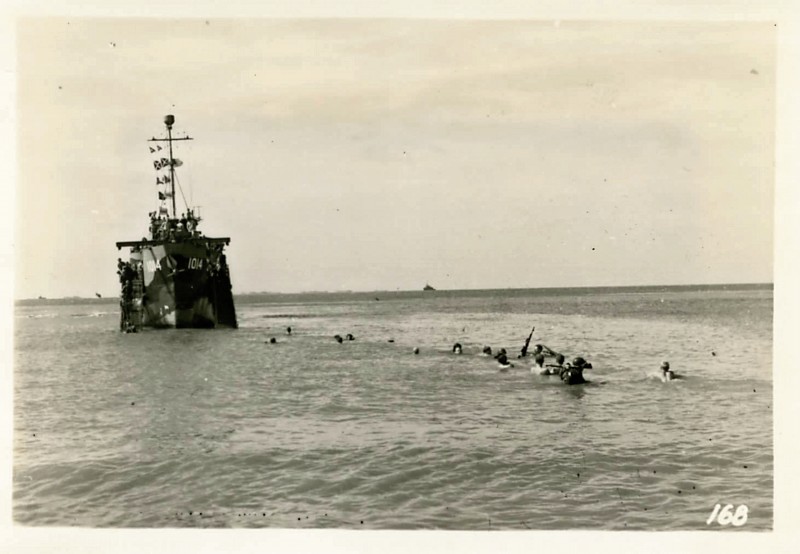
Coming ashore on Panay, March 18
They have to swim ashore because the LCIs cannot approach closer than 75 yards from shore.
Beachmaster reports that Red Beach is not satisfactory.
0935 18 March 1945. Beachmaster landed on the beach, and is making a hydrographic test for small craft.
0953 18 March 1945. Beachmaster advises that RED Beach is unsatisfactory.
Beachmaster reports that Red Beach is not satisfactory for LSMs.
0955 18 March 1945. Commander Task Group 78.3 requests further report from the beachmaster as to whether LSMs can be unloaded there (Red Beach) or not.
The Beachmaster reported that RED BEACH was unsatisfactory for LSMs.
LCI 1022 detailed to investigate Blue Beach.
Meanwhile LCI 1022 was detailed to investigate conditions on BLUE BEACH.
0955 18 March 1945. LCI 1022 is instructed to proceed westward and give a report on BLUE Beach.
LCI 1022 reports that Blue Beach is suitable for LSMs and LSTs.
Reports indicated that BLUE BEACH was suitable for LSMs and LSTs, and
Operations transfer to Blue Beach.
preparations were made for shifting the operations to BLUE BEACH.
1042 18 March 1945. All ships are informed that operations will probably be shifted to BLUE Beach.
1050 18 March 1945. The Beach Party is moving to BLUE Beach.
1051 18 March 1945. Underway for BLUE Beach in the Flagship.
Air Support now reports as stated in operation plan.
After 1100 on G-Day all support aircraft reported on station as stated in the Operation Plan.
LSM 269 lands at Blue Beach.
LSM 269 landed on BLUE BEACH at 1133. 1133 18 March 1945. LSM 269 has beached on BLUE Beach.
LST 924 and priority LSMs ordered to Blue Beach.
(After LSM 269 lands at Blue Beach) Beaching conditions were found favorable and LST 924, together with priority LSMs, were ordered to make landings there.
Strubble orders LSM's 66, 54 and 63 to Blue Beach.
1138 18 March 1945. Commander Task Group 78.3 ordered LSM's 66, 54 and 63 to beach on BLUE Beach.
LSM's 66, 54, 63 and 53 are on their way to Blue Beach.
1147 18 March 1945. LSM's 66, 54, 63, 53 are on their way to BLUE Beach.
By this time, LST 924 has already beached at Blue Beach as well as LSM's 267 and 269.
1147 18 March 1945. LST 924 has already beached as well as LSM's 267 and 269.
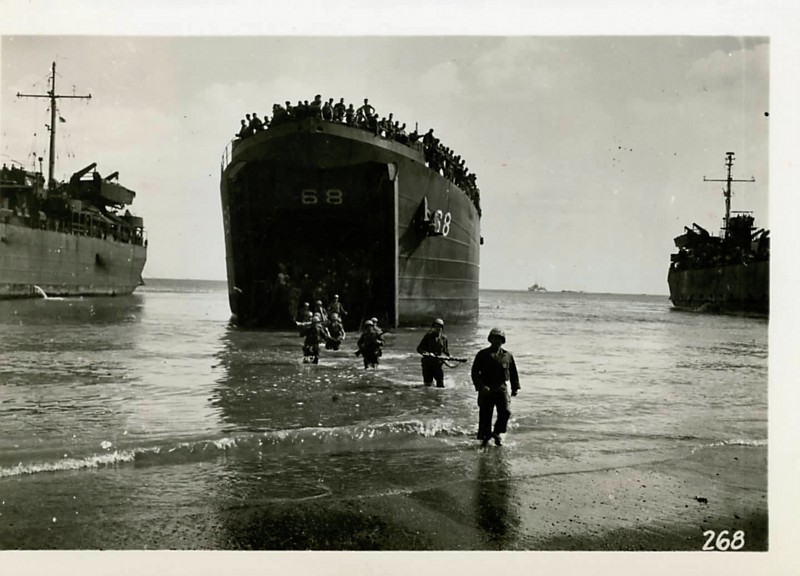
Wading ashore on Panay, 18 March
LSM's 66 and 54 beach at Blue Beach.
1200 18 March 1945. LSM's 66, 54 beached at BLUE Beach.
LSM 53 beaches at Blue Beach.
1205 18 March 1945. LSM 53 beached at BLUE Beach.
LSM's 66, 54, 64, 58 have finished unloading and are retracting.
1224 18 March 1945. LSM's 66, 54, 64, 58 are retracting.
Observation plane reports about the fire in Iloilo.
1225 18 March 1945. Observation plane reports that fire in ILOILO is apparently a brush fire and is in a field 800 yards north of Point PETER. This fire is spreading toward a row of wall storehouses.
Seven LSM's unloaded and retracted from Blue Beach.
1300 18 March 1945. Seven LSM's unloaded and retracted from BLUE Beach.
PT-boat tender Portunus, with 10 PT-boats and two PGMs, arrive from Samar.
The tender PORTUNUS, with ten PTs and two PGMs, arrived off BLUE BEACH at noon. During the afternoon of D-Day, PTs by pairs, working with planes, searched the coastline of PANAY from the landing beach to the south and west, and the coastline of southern GUIMARAS ISLAND and of NEGROS from HINIGARAN south. Pairs of PTs were on regular patrol at night from D-Day on in North GUIMARAS STRAIT, in south ILOILO STRAIT, and off the coast of southwestern PANAY as far as SAN JOSE.
1300 18 March 1945. PT's and tender have arrived.
Twelve A-20's strafe barges off Iloilo.
The Army had little use for the support aircraft on G-Day. The first three groups of A-20's were given barges along ILOILO RIVER to strafe but were not permitted to drop bombs due to the barges being in the ILOILO CITY Area. Upon finding no use for their bombs in the objective area. the A-20's were directed to drop them on a secondary target (BACOLOD strip on NEGROS ISLAND). The last group of A-20's were not assigned a target of any type.
1345 18 March 1945. Twelve A-20's strafed barges off ILOILO town, 6 with unobserved results and 6 with negative results. Barges are believed to have been unserviceable.
.
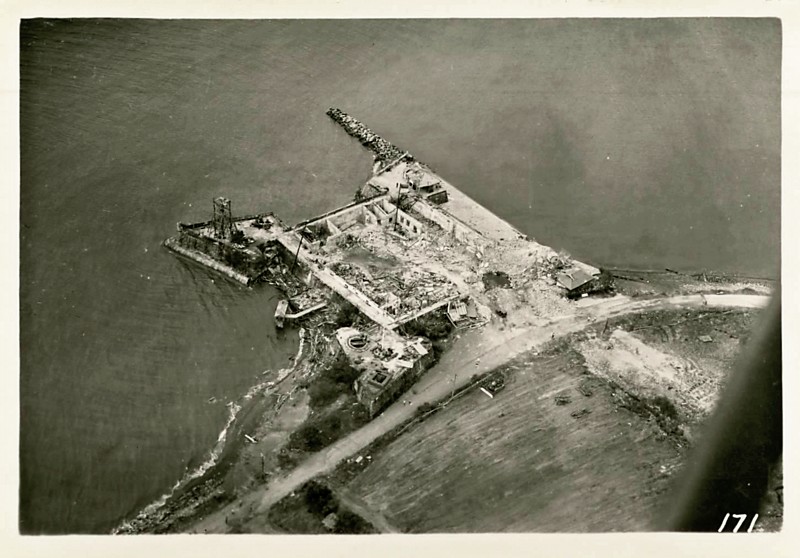
Old Spanish fort destroyed by American planes on Panay
Naval gunfire coordinators land with assault battalions.
Naval Gunfire Liaison Officers and attached Shore Fire Control Parties landed with assault battalions. Communications between SFCP and fire support ships were good.
Call fire was not used.
RCT 185 starts moving east towards Iloilo City.
RCT 185 commenced movement east at 1400.
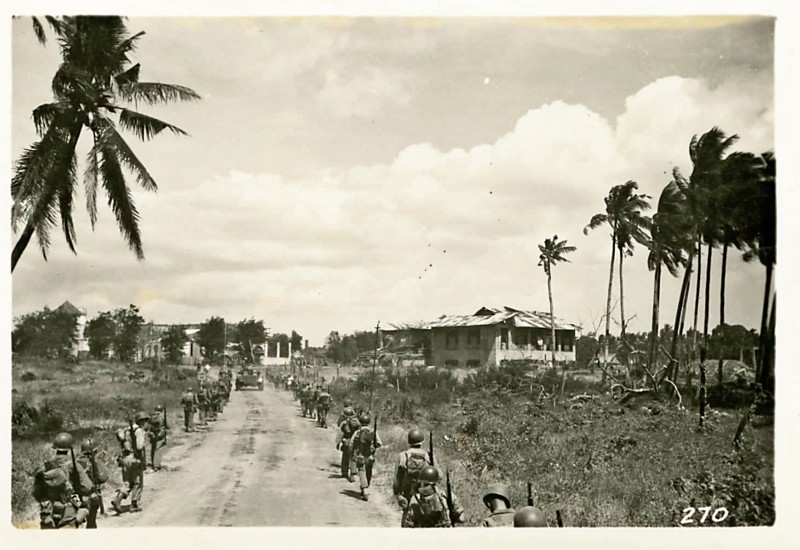
Troops approaching the barrio of Tigbauan
All four infantry battalions are now ashore.
1413 18 March 1945. Four Infantry Battalions now ashore. All armor now ashore.
185th Infantry Regiment in minor contact with Japs in vicinity of Tigbauan.
RCT 185 is in minor contact with the enemy in the vicinity of TIGBAUAN. Seven of the enemy have been killed. Our casualties are three wounded in action.
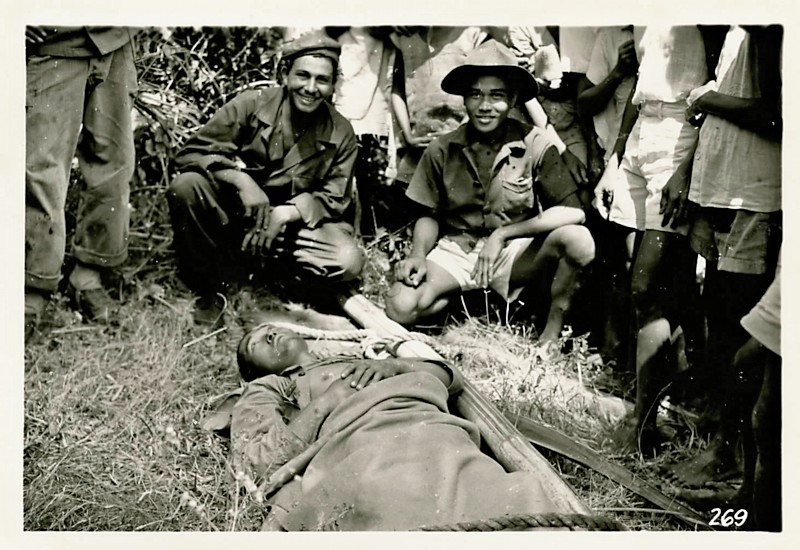
First Jap prisoner taken on the beach at Tigbauan Panay
Courier plane arrives.
1430 18 March 1945. PBY (Courier Plane) arrived.
LCI 663 retracts.
1525 18 March 1945. LCI 663 retracted.
All LCIs and LSMs are now beached, unloaded and retracted.
The Shore Party performed its duties in an expeditious manner and the LCIs and LSMs were beached, unloaded and retracted at 1525.
1525 18 March 1945. All LCI's have now unloaded.
LSTs are then beached at Blue Beach.
The LSTs, less the LST 924, which was already beached, were beached at high water between 1315 and 1530. The unloading of the LSTs proceeded in a very satisfactory manner.
Twelve LST's are now beached at Blue Beach.
1600 18 March 1945. Twelve LST's beached.
Blitzkrieg to Cabatuan, Iloilo by the 2nd Battalion 160th Infantry Regiment.
When the 40th Infantry Division arrived in Iloilo on March 18, 1945, it was composed of 4 Infantry battalions. The 185th Infantry Regiment had all of its three battalions present while the 160th Infantry Regiment had only one battalion present, the "2nd Battalion." Its two other battalions would arrive a few days later.
While the three battalions of the 185th Infantry Regiment marched to Iloilo City, the 2nd Battalion of the 160th Infantry Regiment raced to Cabatuan Airfield and the town of Cabatuan in a mechanized blitzkrieg lightning swoop, by way of Cordova, Leon and San Miguel, to liberate Cabatuan Airfield and Cabatuan. They arrived at Cabatuan that very night, at midnight.
See: Blitzkrieg to Cabatuan, Iloilo
40th Recon Troops engage Japs at Cordova.
1800 18 March 1945. Forty reconnaissance troops made minor contact in the vicinity of CORDOVA receiving light automatic weapon fire and some mortar fire.
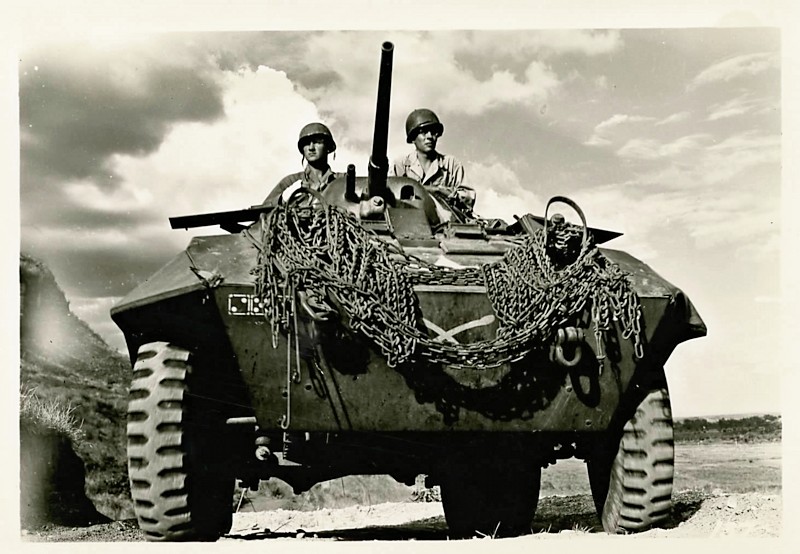
An M-8 of the 40th Recon Troop on patrol, while still in Luzon
USS Thatcher and the LSTs will stay in the area.
1830 18 March 1945. THATCHER, and LST's will stay in area.
USS Thatcher directed to provide illumination and support.
1830 18 March 1945. THATCHER was directed to furnish illumination on request of the Army one to support the anti-small boat screen of LCVP's off the beachhead area which was established for the protection of the beached LST's against Q-boat attacks.
The THATCHER remained off the beachhead as gunfire support and illumination vessel.
The LSTs established an anti-small craft patrol of LCVPs around the beachhead.
Illumination fire on the nights of G-Day and G plus 1 Day was provided to aid PT boats in searches along shores of ILOILO STRAITS.
Maj Gen Rapp Brush assumes command of forces ashore.
Major General RAPP BRUSH assumed command of forces ashore at 1900.
Attack Group retires from beachhead for night.
1910 18 March 1945. Attack Group retired from beachhead for night.
The Attack group, less the LSTs and LCMs, retired from the beachhead for the night.
The Attack Group left the beachhead for night retirement.
Station hospital ship LST 613 remains on the beach.
Medical planning for the PANAY Operation provided for the care of and evacuation of casualties in accordance with the broad plan for casualty care as set forth in the Casualty Doctrine, SEVENTH Amphibious Force, secret serial 00813 of 6 September, 1944.
Three of the sixteen LST's, the 613, 469, and 667 were staffed with sufficient supplies and equipment to furnish adquate medical and surgical treatment at the far beach.
The LST 613 was reenforced with additional personnel so that its medical department comprised four doctors and twenty hospital corpsmen. A dental officer and dental technician with a probable dental unit was aboard.
Surgically equipped LST 613 remained on the beach.
LCI(D) 29, LCI(R) 331 and LCMs remain on the beach.
LCI(D) 29, LCI(R) 331 and LCMs remained on the beach. Moored to LCI(R) 331 was a PBM which had made a forced landing in GUIMARAS STRAIT.
USS Thatcher reports no gunfire support was called for last night.
0725 19 March 1945. THATCHER reported "No gunfire support called for last night. No activity last night. One PGM operating vicinity of OTON touched bank a few times but got off".
Night retirement group moving back to objective area.
The Attack Group ... to return at 0700 the following morning.
0755 19 March 1945. The formation is moving back into the objective area.
B-24 arrives. It reports no activity.
0815 19 March 1945. Air Observer in a B-24 reported on station. He reports no activity in ILOILO town or ILOILO STRAIT.
Six A-20 planes arrive.
0820 19 March 1945. Six 6-20's (must have meant Six A-20's) reported on station. They are orbiting over south tip of GUIMARAS ISLAND.
One SOC plane arrives.
0825 19 March 1945. One SOC reported on station and is maintaining a continuous reconnaisance of ILOILO STRAIT.
All 16 LST's are on the beach.
0845 19 March 1945. All 16 LST's are on the beach.
Night retirement group arrives at objective area.
The night retirement group returned to the objective area at 0900 D plus 1 Day. Commander Task Group 78.3, with members of his staff, went ashore to ascertain the progress of the unloading and inspect tne beachhead area.
All LSTs are unloaded.
0910 19 March 1945. All LST's are unloaded.
USS Ingham achors in objective area.
0915 19 March 1945. Flagship anchored in objective area.
All minesweeping operations yield negative results.
1000 19 March 1945. Areas (near PANAY requiring sweeping) have all been swept with negative results.
All LST's were unloaded and retracted within 24 hours after beaching.
Unloading at the objective area was rapid. All LST's were unloaded and retracted within 24 hours after beaching. Shore party and beach party organization was good and the handling of ships by the individual commanding officers was excellent.
Recommendation. Service platoons of the Army shore parties should be larger.
LST 637, the last ship to unload, retracts.
At 1320 (19 March 1945), LST 637, the last ship to unload, retracted.
1320 19 March 1945. LST 637, last to unload, has retracted from beach.
This leaves station hospital ship LST 613 as the only one still on Blue Beach.
1320 (19 March 1945). leaving only small craft and the surgically equipped LST 613 on BLUE BEACH.
1320 19 March 1945. Hospital LST (613) is only one still on beach.
Large explosion and fires break out in Iloilo.
A violent explosion was heard and a great volume of black smoke was observed in vicinity of ILOILO at 1425, 19 March.
1425 19 March 1945. A large explosion is reported east of Point PETER and west of ILOILO River mouth; cause unidentified. No people are in sight. It appears to be a fuel explosion on dock. Small fires continue to break out in ILOILO city.
1435 19 March 1945. Numerous fires are reported in ILOILO city. One entire block is reported in flames.
1445 19 March 1945. A large explosion and fire is observed in the city one mile north of Point PETER. Appears to be a fuel fire from the large amount of black smoke.
LCI 331 taking a downed PBM plane in tow.
1515 19 March 1945. Commander Destroyer Squadron 46 reports LCI 331 is taking a downed PBM (motor trouble) in tow. PBY #4 is standing by until they get started. It will take several hours to beach V-1 BLUE Beach Area.
Land mines explode on the beach.
Throughout the afternoon many land mines were exploded on the beach by the Army demolition teams.
1605 19 March 1945. A large explosion is observed on beach to the right of RED Beach.
1633 19 March 1945. Another explosion is observed at the same place on the beach, just to the right of RED Beach. It Appears to be a land mine.
Resupply convoy Task Unit 78.3.22 sails for Lingayen.
1657 19 March 1945. Resupply convoy sailed for LINGAYEN as Task Unit 78.3.22 with DYSON, SC 749, LST's 934, 742, 721, 1025, 935, 639, 666, 67, 667, LSM 54 (OTC), 128, 131, 63, 269, 224, 53.
Task Unit 78.3.22 departed for LINGAYEN on a resupply mission. The group consisted of 9 LSTs and 7 LSMs, with the DYSON and SC 749.
Resupply convoy Task Unit 78.3.21 sails for Leyte.
1811 19 March 1945. Resupply convoy sailed for LEYTE as Task Unit 78.3.21 with THATCHER, LST's 924 (OTC), 697, 637, 573, 469, 68, LSM 267, LCI 1022, PGM 4 and PGM 6.
Task Unit 78.3.21, consisting of 6 LSTs, 1 LSM and 1 LCI, with the THATCHER, departed for LEYTE on a resupply mission.
Prior to the departure of the Leyte resupply convoy, all casualties are transferred from the station hospital ship LST 613 to hospital ship LST 469 bound for Leyte.
Prior to departure all casualties were transferred to LEYTE on LST 469. Opposition was light and a total of nineteen patients was evacuated to LEYTE on 19 March, one Navy ambulant case, seven Army litter and eleven Army ambulant cases.
LST 613 designated station hospital ship and remains behind while the other LSTs made resupply trips.
The (LST) 613 was designated as the station hospital ship and remained in the objective area, while the other fifteen made resupply trips.
Second pair of PTs is not refueled.
1820 19 March 1945. Commander Task Unit 70.1.3 advises that salt water in the gasoline barge prevented fueling the second pair of PT's. Unable to supply boats for barrier patrol, the NAVALAS Point landing will be carried out weather permitting.
USS Cleveland instructed to retire for the night, to return tomorrow morning.
1832 19 March 1945. CLEVELAND was instructed to retire for the night. It was further instructed to return in the morning.
LST 613, LSM 65 and LSM 66 are left in assault area for the night.
1900 19 March 1945. LST 613, LSM 65 and LSM 66 are left in assault area for the night.
Retirement group gets underway.
1905 19 March 1945. The retirement group gets underway consisting of INGHAM (OTC); AUSBURNE, CONVERSE; WARREGO; ATR 61; LCI's 546, 579, 663, 955, 962, 1014, 1021, 1064, 548, 1018; PCE(R) 850; SC 748; LCI(R)'s 72, 74, 224; LCI(M) 359; LCI(D) 29 and PORTUNUS.
Army small craft scouts Guimaras Island.
Army small craft scouted GUIMARAS ISLAND during the night of 19 - 20 March.
Illumination.
Illumination fire on the nights of G-Day and G plus 1 Day was provided to aid PT boats in searches along shores of ILOILO STRAITS.
Retirement group returns to anchorage off Blue Beach.
The retirement group returned to anchorage off BLUE Beach at 0730.
Iloilo is secured.
ILOILO was secured on 20 March (D plus 2 Day).
Eichelberger and staff go to Iloilo City.
General Eichelberger and members of his Staff boarded the Flagship and later a party including Rear Admiral STRUBLE went ashore. The party went into ILOIL0 city which troops had opened shortly after noon (20 March 1945).
The Commanding General, EIGHTH Army, who had flown to the area, and Commander Task Group 78.3 entered the City in the early afternoon (20 March 1945) with the Commanding General, 40th Infantry Division.
About 1600 (20 March 1945) General Eichelberger presented a decoration, the Army Distinguished Service Cross, to Colonel PERALTA of the Guerillas Forces of PANAY.
Cleveland, Conway, Eaton and Stevens released from duties.
The CLEVELAND, CONWAY, EATON and STEVENS were released from their duties as Covering Group. Thereafter vessels present remained at the beachhead overnight (20 March 1945).
Station hospital ship LST 613 remains beached and cares for army and navy patients.
The ship (LST 613) remained beached at TIGBAUAN and cared for 12 Army and 2 Navy patients on March 20 and 21. Two of the Army cases died and were turned over to the Graves Registration Service ashore for burial.
Army slow tow convoy arrives.
The army slow tow convoy, with ATR 86, a drydock, gas and shop barges and other craft, arrived off BLUE BEACH on 21 March.
Iloilo beaches considered secure.
21 March 1945. The ILOILO boaches are considered secure and the Army is pursuing the disorganized Jap garrison; for all purposes the Naval portion of the PANAY phase of the VICTOR ONE Operation is completed except for routine resupply which will be handled concurrently with planning of Phase II.
Guimaras Island seized without opposition.
GUIMARAS ISLAND was seized by the Army without opposition on 21 March in a shore-to-shore movement from ILOILO.
Following the landing, the Minesweeping Unit swept various areas in ILOILO STRAITS and GUIMARAS STRAIT. An Army reconnaissance party landed on INAMPULUGAN ISLAND on the night of 22 - 23 March. This party discovered a station which controlled electrical mines sown in GUIMARAS STRAIT off the eastern tip of the island. The cables were cut and the minefield made inoperative. The minesweeping continued, in order to clear the straits for shipping and in anticipaticn of a landing on NEGROS as soon as the military situation on PANAY permitted.

Station hospital ship LST 613 remains in objective area.
Although the Naval Assault Phase of the PANAY Operation terminated on 21 March, the 613 remained in the objective area and continued to receive and treat patients daily. A total of 30 Army and six Navy cases and one civilian patient (A Filipino child accidentally wounded by a bursting Japanese grenade) was cared for from March 22 to March 25.

